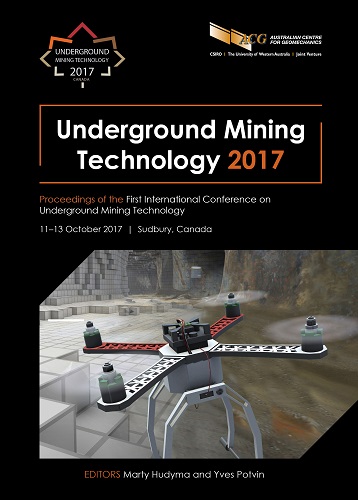Application of the GeoSequencing Module to ensure optimised underground mine schedules with reduced geotechnical risk

|
Authors: Hauta, R; Whittier, M; Fava, L |
DOI https://doi.org/10.36487/ACG_rep/1710_44_Hauta
Cite As:
Hauta, R, Whittier, M & Fava, L 2017, 'Application of the GeoSequencing Module to ensure optimised underground mine schedules with reduced geotechnical risk', in M Hudyma & Y Potvin (eds), UMT 2017: Proceedings of the First International Conference on Underground Mining Technology, Australian Centre for Geomechanics, Perth, pp. 547-555, https://doi.org/10.36487/ACG_rep/1710_44_Hauta
Abstract:
Conventionally, engineers will impose stope sequencing rules in order to ensure the stability of excavations as mining progresses. Typical rules include fixed direction, primary-secondary and chevron. Using a mine planning software suite, a mine layout is designed, and a set of stope-to-stope precedence links are created, enforcing the applicable rule. The mine planner produces a schedule that meets these and other constraints, in an effort to achieve a high net present value (NPV) for the operation. This time-consuming process limits the planner’s ability to assess alternative mining strategies. Further, the process tends to over-constrain the mine schedule, since it is often the case that an alternative set of precedence constraints can enforce the same rule. By overconstraining the schedule, and by not assessing alternative strategies, significant value may be lost. The GeoSequencing Module is software that facilitates the assessment of stope sequencing strategies, through integration with the Schedule Optimization Tool (SOT). The GeoSequencing Module rapidly generates multiple alternative sets of stope-to-stope precedence links that enforce stope sequencing rules selected by the user. Each set of precedence links is referred to as a geosequencing scenario. For each geosequencing scenario, SOT optimises the life-of-mine schedule, allowing the planner to identify the scenario that supports the highest value for the mining operation. Furthermore, the software has been integrated with a boundary element solver, facilitating assessment of the geotechnical stability of the optimised schedules. A case study for an underground mine has been conducted to validate this methodology. The study demonstrates that multiple mining strategies can be conveniently assessed to determine which scenario yields the most desirable outcome for the mining operation in terms of both geotechnical stability and financial assessment.
Keywords: mine planning, mine schedule optimisation, geomechanics, stope sequencing, numerical modelling
References:
Fava, L, Millar, D & Maybee, B 2011, ‘Scenario evaluation through mine schedule optimisation’, in R Kuyvenhoven, E Rubio & M Smith (eds), Proceedings of the 2nd International Seminar on Mine Planning, Gecamin, Santiago, pp. 1–10.
May, W 2014, An Investigation of Induced Rock Stress and Related Damage in Popular Stope Sequencing Options Using Numerical Modelling, CSMM152 – dissertation project, Camborne School of Mines, Penryn.
Maybee, B, Fava, L, Dunn, P, Wilson, S & Fitzgerald, J 2010, ‘Toward optimum value in underground mine scheduling’, CIM Journal, vol. 1, no. 3, pp. 176–182.
Morrison, DM 1996, ‘Deep hardrock mining: the future’, CIM Bulletin, vol. 89, no. 1000, pp. 46–51.
Revolution Mining Software Inc. 2017, Schedule Optimization Tool, version 2.0, Revolution Mining Software Inc., viewed 5 July 2017,
© Copyright 2025, Australian Centre for Geomechanics (ACG), The University of Western Australia. All rights reserved.
View copyright/legal information
Please direct any queries or error reports to repository-acg@uwa.edu.au
View copyright/legal information
Please direct any queries or error reports to repository-acg@uwa.edu.au